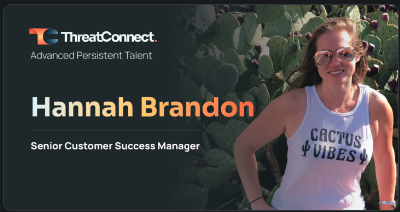Posted
The Advanced Persistent Talent series profiles ThreatConnect employees and explores how their work impacts products and offerings, how they got here, and their views on the industry at large. Want to know more about a particular team? Let us know!
People find their way to the world of threat intelligence in all sorts of ways. Some start on a traditional path by working early as analysts. Others decide to turn cybersecurity from an interest or passion into a full-time career. And many others come from different backgrounds completely.
Take ThreatConnect’s Senior Customer Success Manager, Hannah Brandon. Hannah started her career in education as a preschool teacher. After deciding education wasn’t quite right for her, Hannah worked her way into the world of cybersecurity, eventually landing at ThreatConnect.
Today, Hannah’s passion for problem-solving and helping others lets her build strong, more authentic customer relationships. Read on to learn more about how Hannah traded a background in building blocks and ABCs for a work environment filled with fighting cyber adversaries.
The following conversation has been edited for clarity and length.
ThreatConnect: How did you get into threat intelligence?
Hannah Brandon: I don’t think there’s a traditional way into the space. I was in childcare for nine years and just reached a point where I realized I didn’t really want to be a teacher.
So as a young adult switching gears in the workforce, I realized I was going to need to start at the bottom. I went to my community college internship fair and got an internship as a marketing associate for an IT and cybersecurity training company.
From there, it blossomed. I learned more about IT from the certification side of the house. As a marketing associate or marketing intern turned full-time marketer, you have to dig in and really understand who you’re working with and their pain points. I focused on certifications required by the government.
I finally eclipsed more time in cybersecurity than childcare this past year.
Are there any similarities between teaching and cybersecurity? Or are they too different?
I like helping people, and every role I’ve ever found myself in has some level of that.
What does your current role at ThreatConnect look like?
I’m a Senior Customer Success Manager. My main job is making sure that our customers get value out of their purchase of ThreatConnect, whatever that looks like for them.
A lot of that is making sure my customers are adopting new features of the platform and making sure that they’re equipped with the tools and knowledge to utilize those features. Sometimes it’s having them take a step back and looking at that bigger picture. I couldn’t say I have a regular day-to-day.
What are the most challenging or interesting parts of your job?
Each customer is very unique. We could have two customers that are both global hotel chains, but what they’re focused on is very different, even though on the surface they’re exactly the same.
One of the most interesting challenges is seeing how new features really fit into their already established workflows. When we have customers that have been with ThreatConnect for four, five, or six years, they’ve already established a workflow without those features. So the challenge is figuring out how to get them to adopt those new features and put them into their workflow. Often it seems like a bit of a lift, but once it’s done, they’re like, “Oh, okay. This makes so much more sense.”
How do you build relationships with your customers?
I’m very open and honest with all of my customers, probably to a fault.
For example, I will sell you out of something. I don’t want to expand a customer within different ThreatConnect products if I don’t think it’s really going to help them. Otherwise, I’ll have a customer who’s not using anything or is like, “Why did I buy this?” I don’t want that.
For example, I had a customer who needed more playbook workers—basically, the backend that powers the automations in ThreatConnect. I could sell them more workers, or I could look at the bigger overall picture and say, “I see you already are also paying for some additional users. You don’t want all four workers.” And instead of them buying a playbook server, which includes four workers, I said, let’s get you to the next product line because it’ll get you exactly everything you need at a lesser cost.
I need my customers to trust that I’m actually looking at what they’re asking for and looking for. I’m not here to just take orders. I’m here to understand: What are we trying to accomplish?
It boils down to problem solving—really being understanding and empathetic to what our customers are facing in terms of challenges from their side. And then also understanding how ThreatConnect can help them with that.
Outside of your nine-to-five working day, what are a few things that you’re spending your time on?
I love being outside. But I also recently moved to a southern state where the mosquitoes are about as big as a baseball. (No, just kidding. They’re not that big.)
I love playing disc golf, but it’s getting super hot already. So I have to go super early in the morning.
Is there anything else that people should know about you?
I am naturally curious and always want to learn. So even though I claim not to be the technical person, I don’t want there to be a hesitancy to not ask me. Because I’m going to find the answer or the person who knows the answer, and then make sure that I understand it well enough that I can articulate it back.
That’s who I am, right? I love questions that make me pause and think, and have that lightbulb moment.
